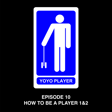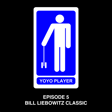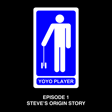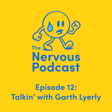Become a Creator today!Start creating today - Share your story with the world!
Start for free
00:00:00
00:00:01

Oral History of 3A
Steve and Mark talk through the history of 3A style, which started as a joke used for publicity photos in the 50s and became a full-blown style once Mark got his hands around it.
This episode brought to you by YoYoExpert.com.
Theme music is "Runaway" by Reconciler.
Recommended
Transcript
Introduction to 'Yo-Yo Player' Podcast
00:00:29
Speaker
This is Steve Brown and Mark McBride. And this is Yo-Yo Player, a podcast where two dusty old farts recount their glory days, badly. Can you hear the dust falling off of me when I move like this?
00:00:45
Speaker
I don't know if I can hear the dust, but you can definitely hear my knees pop. Oh yeah. Constantly. Oh God, I heard that. Was that your wrists? Was that your back? What the hell was that noise? I don't even know anymore. Oh, that's the worst. The worst is yeah. I've had that happen. I've had something pop. Jenny was like, what the hell was that? And I'm like, I couldn't tell you.
The Lost 3A Yo-Yo Recording Plan
00:01:10
Speaker
So the last time we recorded, we recorded the oral history of 3A and the oral history of 5A and the oral history of 3A files got corrupted. So they're gone. They were just too powerful. It was too powerful. It was too powerful of a style. This is going to be the oral history of 3A redone. Like I haven't told this story before. I know. Well, and that's the funny thing is that we have to like rerecord the story that you've told a hundred times.
00:01:37
Speaker
It's going to be interesting because I'm wondering how much of the original recording session we're going to remember as we're doing this one. Uh, I'm trying not to try. I'm trying to just go like empty teacup, just start fresh and just roll
Authenticity and Evolution of Yo-Yo Tricks
00:01:51
Speaker
with it. You know? So there, there is technically vintage
00:01:56
Speaker
like records of yo-yo players doing trapeze and like a one-handed star. You know what I mean? Like there is there, you know, or like a one-handed star with both hands. There are pictures like promo shots from the 50s. I honestly don't know. And I've asked Dale Oliver about this before. I don't know how much of it people actually did versus how much of it they like staged to make a cool promo shot. But I'm sure at some point, like the better players
00:02:23
Speaker
which try and figure out how to do like rock the baby with two yo-yos, you know, things like that. This is a constant philosophical battle I have with young humans, especially young players, which is the label follows the tricks. The tricks don't follow the label, you know? So a trick is a trick is a trick. It's only if you slap a label onto it. So all these people would be like, but is it three hours of five, eight? Like it's a trick. It's a trick. You know, like you're lit, the labels came later. So,
00:02:53
Speaker
all that to say that there were definitely tricks done which fit the categorization of 3A, which was two yo-yos in a trick where the strings cross or bend. That was the distinction. And even that kind of starts to fall apart because you eventually had like Venkman and Twister tricks like that to work with. And so it's tough to just say like,
00:03:22
Speaker
Oh yes, this happened. This, you know, it started at this day, started that day. So you're right. The tricks that I've seen were a double rock the baby. As far as I can, you know, as far as I know, that was the.
00:03:37
Speaker
triple eight trick, which preceded anything. That was, and there's like, there's some really nice, like old promo shots of Bob rule doing that. There's a couple of, there's a couple of promo shots from like, I want to say late seventies, early eighties of Dale Oliver during his like play max time. Yeah. So maybe that was actually like late eighties when he was with play max doing like that double rock the baby.
00:04:01
Speaker
The thing is, though, is that like I don't and like so this is the same thing with counterweight. There's technically patents that show a handle that you attach to the end of a yo-yo string.
00:04:14
Speaker
but it was literally meant to just like aid in like kids gripping the string. There was like no mention of ever releasing it. That was never the goal. And like same thing with 3A, like as we got further along, we started to find random little like staged promo shots, but we don't have much of an indication that people were actually actively doing tricks, string tricks with two yo-yos at one time. So like, I know that you gray old hippie ass is always like,
00:04:42
Speaker
We don't make tricks, man. We just discover them. They all exist already in the ether. The trick is its own soul, man. It just kind of comes in and possesses your yo-yo, dude. You don't own that trick.
00:04:55
Speaker
I will never get over what a straight edge hippie you are.
Mark McBride's Modern 3A Contributions
00:04:59
Speaker
It cracks me up. It cracks me up to no end. But like realistically, you created modern 3A. Yeah, that's fair. I think that that's like a kind of a delineation that we can very easily put on that you can agree with, I can agree with.
00:05:16
Speaker
And that is that like, you know, what we can currently consider to be three, a that started with Mark McBride. Yeah, that you can definitely trace that back to.
00:05:29
Speaker
Tricks that stop at me if you go backwards in time. Yeah, you know and I think that that's fair and That was one of my favorite compliments was actually Fucking rad. It is. It's super rad. Let's just I mean, let's you know I know we're old and jaded and everything but like let's just stop and like take a minute to appreciate that like I
00:05:50
Speaker
you know, you can take this entire style of play and you can trace it back and at some point it just dead ends into you. Yeah. And that was actually one of my favorite compliments that Ben McPhee gave to me because he wasn't trying to compliment me. I think he was actually trying to mess with me, but he was like so- Ben never tries to compliment anybody. No, not at all. And that's why it makes it so great that I'm like, ha ha, you complimented me, motherfucker.
00:06:20
Speaker
Was he said, he's like, yeah, if you, if you follow a lineage of a, of a trick backwards, as far as like who taught, who taught, who taught, who taught, who like all these triple A tricks, they, they cap at you dude. And I'm like, yeah, that's why everyone keeps saying that I invented it. So a lot of it goes back to, in fact, I mean, you could argue that it all goes back to velvet rolls.
00:06:50
Speaker
Yeah. I think that was really the kickoff point, the turn in the line. Now, one thing that we'll get back to later that we have to own is that there was the legend, the conceptual legend, which is double trapeze. Yeah. So I'd always thought about like, you should be able to do double trapeze, could never do it. And the practical execution of it was like, it's impossible.
00:07:20
Speaker
Yeah. Let's just leave that dangling. It'll come back later. Well, but let's also stop and enjoy like how bad the equipment was at the time that we were trying to do all this on. Yeah. It was bad. Like, and it was, it's one of those things that like, I never, I never feel like I can really adequately explain to like people who are starting now.
00:07:56
Speaker
work and discover trick, then once you've worked and discovered it, you get good enough where you're like, wait, I can do this on this yo-yo, on a fixie, on a narrow gap yo-yo. Like, you reverse, you know, work it down. That happened with AAA too. And so a little bit as strange as it sounds, the component of this was
00:08:05
Speaker
how much better their equipment is that they have
00:08:20
Speaker
a long lost yo-yo that nobody liked but me, which was the Omega Wing Force. Yeah, I don't know if I'd call it long lost so much as terrible. Like, archived mothballed, locked away in an asylum yo-yo. It was an outlier too, because- Super outlier. Well, at the time, like, the Omega's product line was for the technology that was available, like, it was really good.
00:08:47
Speaker
Yeah, you know and they had they had a bunch of really good yo-yos and they had a bunch of yo-yos that people very much preferred For certain styles of play. They had not really cracked the code on 1a But the wing force the interesting thing about the wing force is I believe they had a manufacturing patent on it Because it was stamped instead of yes, so contextually there was only only Omega and
00:09:16
Speaker
Tom Coon were putting out bearing yoyos. Transaxle yoyos of any kind. Yoyo had a patent on sleeve bearings, which was most of them, or excuse me, just sleeves. Tom Coon, because they put out a bearing based on another yoyo, like a long lost yoyo.
00:09:39
Speaker
Yeah, so what was silver bullet two? Yeah, the silver bullet two. So they could do the roller way, they could do the silver bullet two. So that was the only metal yo-yo, and it was amazing. It really was a great yo-yo, it was top notch yo-yo, and that was the yo-yo that everyone in classic kid fashion said, I gotta have the $100 yo-yo, it's obviously five times better than the $20 yo-yo. And we're like, okay,
Evolution of Yo-Yo Equipment
00:10:01
Speaker
whatever. So, yo-mega said we need a metal yo-yo.
00:10:07
Speaker
But let's make a cheap metal yo-yo. Instead of machining it, they wanted to stamp it. So they made this yo-yo that they stamped. So the curvature could only be so much because you can only stamp heavy metal like a certain number of degrees, right? And you couldn't do it too much. So I don't know if it was a conscious choice or not conscious. So it actually had a lower diameter.
00:10:32
Speaker
than pretty much anything on the market at the time. It was just slightly undersized, which I still actually love. Yo, yo, is there just a tiny bit undersized? I mean, it was a, it was a good diameter for sure. Yeah. It was just a little bit low, a little bit lower diameter and
00:10:48
Speaker
because it was, you know, and it was a butterfly as much as it could, but still wasn't very wide. So it was this narrow butterfly, but it wasn't rounded, it like went to a point. So it was, in many ways, it was two satellite dishes that weren't that deep, butt to butt. So that meant that it was really great for small, complicated string tricks, because it was also heavy,
00:11:17
Speaker
And also that no normal kid would want to play with this yo-yo. So it's interesting, like I'm doing some Google Fu here while you're talking, and the wing force is a 57 millimeter diameter. That's not that small. No, it was smaller than the radar. I mean, yeah, that's fair. Which was the yo-yo at the time. Like it's smaller than anything Tom Kuhn put out, smaller than the radar, smaller than anything BC put out.
00:11:44
Speaker
So what's the what's the diameter on the radar? 58 I mean really barely. Yeah, I think it was out so much smaller. I think it was the thinness and the width Yes, I'm also looking at like for me. I feel like the The one-drop project kind of kicked off like the 50 millimeter yo-yo craze. Yeah
00:12:05
Speaker
Which is to say, like, it was, I mean, it was definitely like, I mean, everybody considered 50 millimeters to be undersized at that point. Right. And at the time, you know, going from like 57, 58 millimeters to 50 was undersized, but that was like a great size. That
Concept of Velvet Rolls Trick
00:12:20
Speaker
is the exact threshold.
00:12:21
Speaker
of like, if you're 50 millimeters under. Anyway, but like, it's weird to go back because I specifically remember the wing force also being really, really small. And then to look at the specs and be like, yeah, it was a millimeter smaller in diameter and that's it. It's kind of like... We're so inside baseball at this point, dude. I know. I know. Get back to the story. Let's get back to the story. So the story goes, I'm working for Yomega. I'm the only one that likes these wacky string trick yo-yos.
00:12:50
Speaker
Right. Because everyone else is doing 2A at this time in history. Everybody's doing 2A. 2A is the aspiration. Yeah. And so- And screw that. Yeah, exactly. I had the idea, I'm doing the string tricks, I'm doing the stuff which really didn't have a home at this point in history. And I had this idea that as I was doing brain twister, you could symmetrically do this trick. You should be able to do a brain twister where you have
00:13:19
Speaker
Your throw hand on one hand, and free hand on the other, and then the throw on that hand, and then free on the other. They fit, you know? And I actually drew it out in a notebook. It was a yo-yo trick that was done on paper before it was ever picked up. I drew the end kind of layout. And again, by this point in history, this is pretty much exactly when I have finished the Yonah Makan, and it was just about to be released.
00:13:47
Speaker
So, you know, I'm going to have to release, but it was like, I had done all the work on it. So that's, I was already thinking in lines and dots. So I drew it out and then I was like, okay, how would I get into that hold? And then I drew a hold before that and hold before that. And I did a reverse comic strip of how this trick could happen. Which is absurd.
00:14:11
Speaker
Fun note, that notebook is in the National Yoseum right now. You can see the actual notebook. Oh my God. I had to go back and when I gave it to those guys, before I gave it to them, I had to go through that notebook and be like, is there anything in this notebook? This is like an engineering random scribble notebook. Is there anything in here that should not be outside of my control and would incriminate anybody involved in that era?
00:14:40
Speaker
Please pay no attention to the boobs I drew on page 38. Exactly. The list of phone numbers that starts with Angela. Oh my God. Can you imagine if the National Yo-Yo Museum had, you know, what they believed to be, you know, like, oh, this is the written origins of 3A. And it was like, also it was Mark McBride's A Little Black Book from the 1970s.
00:15:10
Speaker
So, I do this trick and it was supposed to be brain twister. It's supposed to be like, whoo, whoo, whoo, whoo. You know, brain twister is a fascinating trick. But turns out that when you go over one to get into it, it flops.
00:15:29
Speaker
It like you can't keep two of them straight out unless you're going really fast. So yeah, there's no medium speed for that trick You either go slow or very fast and anything in between just shits the bed. It's like a it's like the Hot Wheels loop like you have Exactly. So what was supposed to be the fast trick I came through to the slow trick it but that ended up being a fine cool trick on its own, you know, yeah, and so that became velvet rolls and
00:15:56
Speaker
Now here's the thing. I seem to remember that there was a bet that centered around this. There was. So the way that the, the bet came later, the bet was. So wait, the bet came post concept for the trick. Yeah. Or did the, did the bet come post concept, but pre execution.
00:16:20
Speaker
No, the bet that you're thinking of that we had, that you and I, it was the one between you and I where we had to chase like the scavenger hunt. That was a separate one. Oh, then what were you thinking of? We had a steak dinner bet about velvet rolls. Okay.
00:16:36
Speaker
because you had come up with the idea on paper, but hadn't figured out quite yet how to make it work physically. And there was, there was some race to see like who could do, and I feel like this is even in like a fiend magazine somewhere. So I think what you're mixing up is the other bet with the race was with Felix, who could do blue line rolls, blue line rolls first and then Taco Bell.
00:17:04
Speaker
No, this was a steak dinner bet that involved velvet rolls. See, the problem is, is you and I have done this too many times. We've done this way too many times and it's almost always a steak dinner. And we also almost always never deliver. No, because, um, cause we don't live anywhere near each other anymore. I always forget. No, the velvet rolls I did by myself in my apartment and then
00:17:33
Speaker
Showed you it done. I didn't tell you I remember cuz you would come out to LA before Chico where I showed it off and went and I went like hey check this out and That I have to admit that was that was one of the only few times that I've seen Steve Brown like Impressed and even then you were just kind of okay. That's a thing So kids out there if you ever show Steve Brown something and he goes
00:18:02
Speaker
That's a thing. Congratulations. Yeah. I mean, it's like, have you ever heard the old joke? Like, how does a comedian laugh? That's funny. Like, that's it. Like, you know, you watch comedians watching other comedians. They don't laugh. They're just like, it's really funny. It's it. Like, that's that's kind of how yo-yo players are with tricks. And that's I mean, it's definitely how I've always been. I'll be watching. I'll be like, oh, damn, that was really cool. And then I'll walk away and obsess about it for like six months.
00:18:32
Speaker
You did. You once told me, and you told me at some point in history, like at some point over the years, you're like, dude, after you show me that I like walked away and like had to sit down and was like, damn. Yeah. Meanwhile, at the time you're just like, yo, cool. Good. Anyway, let's go to fat burger. So the
Scavenger Hunt and Fiend Magazine
00:18:52
Speaker
bet that you were talking about. Yeah.
00:18:55
Speaker
was with Fiend. I don't know what the steak dinner bet was. I vaguely remember that there was one and I know that we made like five of those at some point just in that year alone. Yeah, there was the scavenger hunt, which I found some of those photos the other day when I was digging around. We had to get photos of us yo-yoing with celebrities or in interesting places. So let's lead into that one for a second. So the bet that we do know about Velvet Rolls came
00:19:24
Speaker
because at the time I would show velvet rolls to people, because again, this is pre-internet. This is pre-internet. And this is also the era where themed magazine. It was analog viral. Analog viral, which is, I mean, it's super cool, dude. I mean, really like we would be at contest. We would be at contest and I would tell people like, dude, go tell, go see Mark and tell him to show you his trick. And they're like, what are you talking about? Just go tell him to show you the trick.
00:19:53
Speaker
Like that was the only way. Yeah. That was, but that was literally how we spread it. And so like, I feel like it was at nationals and Chico, like all day long, people come up to me. Oh, it's Chico idea. Yeah. It was the only, it was the only year that I've been cool at Chico. So we were publishing Fiend magazine. It just had their first like issue come out and
00:20:23
Speaker
Greg Cohen, who was publishing Fiend magazine, later became the organizer of the world Yoyo contest, said, we should really put that in as a trick instructional.
00:20:38
Speaker
No, I'm too punk rock. It's all about learning it, those who've earned it. And somehow you got involved, and somehow we had this scavenger hunt. That was the bet. The bet was if I won the scavenger hunt, you had to publish the instructions for velvet rolls. That's what it was. Yeah. OK. Yeah. And so eventually, yeah, we did. So you and I had a bet on who could
00:21:07
Speaker
who could get the pictures with the most notable people with whatever notable thing they were known for, what made them notable. So I got a picture in Tom Coon's Zen Garden with Tom Coon. And I can't remember which one of us got a picture of Julius wearing Julius' goggles. And one of us got Hans wearing Hans' hat.
00:21:33
Speaker
Julius was definitely you because I didn't want anything to do with that dude or his stinky leather hat. And you got like Hans and Hans's hat, I think one of us got Hans and Hans's hat.
00:21:42
Speaker
Uh, I got Hans's hat. I got Dale Meyerberg suspenders with like all the flare buttons and stuff on it. I got, I got Arnie Dixon, Arnie Dixon, Arnie Dixon's, uh, I got Arnie Dixon's red tiger stripe jacket and the cover of the old Duncan VHS, which then ended up becoming the cover of an infinite illusions catalog. And I think you got build a boys and blanks glove, his nylon glove.
00:22:08
Speaker
I don't know if I got that or you got that. I thought it was you. We got Jason Tracy. Someone got Jason Tracy. I got, I was sure as me and I got, cause I got all the BC guys. Yeah. I mean, we definitely like we, we, we did the list. I got Dick stores that yo-yo guy jacket. Nice. Um,
00:22:27
Speaker
Yeah, there was a, you know, I mean, it was a, it was a handful of like specific touchstones of that time. So I, we got, I think together we got Neil Gaiman that will, like, we got, we went beyond yo-yo people and we went into Neil Gaiman's black leather jacket, which was
3A Yo-Yo Innovations
00:23:03
Speaker
Takes it immediately throws it does a picture perfect rock the baby looks at me and goes damn This thing spins like a motherfucker and we're both like that's it. We're done. We're done. It's over That's how you be because you saw Sam Jackson and walked up to him and gave him the yo-yo because we were both at Golden Apple that day and I think yeah, I think Bill took a picture with both of us, but I was like
00:23:06
Speaker
the cool one.
00:23:26
Speaker
As the gentleman, I know when I'm beat. That was pretty good. That was pretty fantastic. That was, that was easily like of all the weird celebrity encounters I've had in my life. That was by far the fucking coolest. That was fun. So, so we published the, we published the art of how to do velvet rolls in Fiend magazine. Now here's the thing that got me that I thought was obvious, but turns out isn't, is there's a big banana in the middle of the art.
00:23:56
Speaker
It wraps around a picture of a banana. And everybody was baffled by why is there a banana in the middle of the velvet rolls? Yeah, it's because all these kids were listening to fucking Alice DJ instead of the velvet underground.
00:24:14
Speaker
Exactly, and that was the story. The reason Velvet Rolls is called Velvet Rolls is because that night in my apartment when I first did it, I happened to have Velvet Underground on and I said, this is a great trick. I wonder what I'll call. It needs a name.
00:24:30
Speaker
And then Lou Reed went like, oh, hey, Velvet Underground, Velvet Rolls. Funny Velvet Underground story. I was revisiting some old Velvet Underground and Lou Reed stuff. And you know that iconic baseline for Walk on the Wild Side? Yeah.
00:24:46
Speaker
Yeah. So that's technically two baselines moving in opposing directions at the same time, because the, the bass player on that session found out that they weren't getting paid by the song. They were getting paid by the track. So he came up with a baseline that was two separate tracks. Cause he was like, fuck y'all I'm getting paid twice. Dude, that plays it so well to the history of three a now that's even, that improves it. I'm going to tell from now on that's going to tell people why I called it velvet on like velvet rolls.
00:25:16
Speaker
So at some point in the future, I'm going to tell that story and people are going to be like, nah, man, I heard that podcast. I know that you changed that name in 2024. Good. Well, there we go. Like that's a good reason to listen to our podcast is to find out if we were bullshitting later.
00:25:31
Speaker
Yeah. And it was great. And like, you know, we started sharing it again at this time in history, there was no internet. So it was all about like who you ran into and people showed people. And then one of the people that like it got back around too. And he always tells the stories, Rick Wyatt, that he saw and it was just like, whoa, amazing kind of thing. And he ended up coming up with the most complex, insane triple A trick at the time that we couldn't duplicate.
00:26:01
Speaker
for years until like I sat down and like really like much like velvet rolls. Like when I pinned him down and drew it out, I was like, Oh, it's actually not that complicated. You're just getting into it really weird called Voodoo. And his Voodoo was like, it wasn't a bottom out. It was like double split bottom mounts or something. Wasn't it? So what it was is that one of them was an open mount and one of them was a closed mount. So he was doing velvet rolls on one side and like bell roll on the other.
00:26:28
Speaker
And the way that he got into it was insane. Once you figure out what conceptually what it is, it's super easy to get into. But if you don't know where you're going, the steps that he organically fumbled into to get to it is amazing. So was that the second 3A trick or was it assisted suicide?
00:26:48
Speaker
I don't know. So these were all happening in parallel, right? You were starting, like at some point you did assisted suicide. I think that was much later though. Cause suicide was the first three, a trick I made, which is really stupid when you think about it, because it's like absurdly difficult. Yeah. And so that was the other thing that made it really funny was that
00:27:10
Speaker
3A has a history of starting with the most ridiculous, complicated one and then going backwards. I would say the second true AAA trick, the second one that I came up with as a true AAA trick would have been Venkman in 99. Now again, between 98 and 99,
00:27:30
Speaker
other stuff was happening. Taylor Whitley and John Huber in Arizona were coming up with stuff. I give them a lot of credit. I want to say that Mach 10 actually came out of them or it was like the Warped Tour stop when we were in Arizona. I was doing Mach 10 with those guys. Mach 10 I worked on really early. That one may have been a race. Yeah, I think that was a race that we were all together because that was definitely the Warped Tour era that we were all together.
00:27:56
Speaker
But I remember that like very much like once we like once everybody started learning velvet rolls, then it became this race to see like, well, what other 1A tricks can we double? You know what I mean? Can we duplicate? And we all started like rushing. I know I was working on mock tents independently of them. I think they figured it out sooner. The great thing about Taylor and John is that they were also doing the exact same thing with 5A.
00:28:23
Speaker
So like like like Beasting came out of came from Taylor Whitley like the you know, there was some like really fantastic like foundational early 5a that came from those guys Oh, those guys are amazing. Those two like deserve so much more credit than they get in yo-yo history Yeah, and so and the other one that was really hilarious and we'll get back to the significance of this is that um
00:28:47
Speaker
The first kink trick. Now kink was where you put two, you know, string trick, it was string to string tricks. So, I mean, to be fair, again, 99, one of my favorite tricks, which is lost in history, but I loved it, was Venkman, which was two opposing around the worlds. Like you do one, one one way, one the other, they cross above you, and then you shift the plane and let it fall, and then they untwist. So,
00:29:16
Speaker
It was basically like nowadays, you know, yeah, exactly. 10 years later, they figured out if you do it vertically, it's so much easier, but I was doing it horizontally and crossing the planes of where the yo-yo was. Again, like, man, did we just fucking do everything the hardest way possible or what? And the short answer is yes. But the other one that was, that I did to be a dick was
00:29:39
Speaker
Buckets of king the first one where like it like flash forward a few years. Jason Lee in that like early super tech when like when like the super tech really kicked in like what we called sweater knitting. You know was a thing and I was to mock it I was like I'm gonna come up with the most string to string to string to string trick I could think of.
00:30:04
Speaker
which was to do drop in a bucket, except I was like, wait, this is just a hook. Yeah, I should be able to do that with two yo-yos, like you've replaced the freehand with the other side. And so again, I reverse engine, not reverse engineered, but I was like, I started with where I wanted to get to, drew it, and then figured out how to get into it. Like, so I was like, ha! And I remember making a video for this that would be like uploaded, downloaded, because it was no YouTube.
00:30:29
Speaker
It put that in. I was like, look at this trick. This is insane. In my head, I'm like, this is the dumbest fucking trick because it is so unnecessarily complicated because it literally had like one, two, three, four, five, six, like all these string to string links. Yeah. And then I put it, I was like, ha, screw you and your tech shit, Jason Lee sweater knitting bullshit.
00:30:54
Speaker
Then, of course, the next trick was, you know, I could really just do a kink trapeze. So I was like, oh, you only have to do one of these. So it was one. And then that was the one that was another, like, race to name was.
00:31:14
Speaker
that at some point, so I was like, oh, if you could do an over and under version of this, so you do a link trick, string to string, undermount one side, overmount the other, and then you should be able to do it as rules. And I was like, oh, it was just a conceptual idea. And then there was a DXL meet. Now, this is early DXL where it was still just like,
00:31:34
Speaker
Glass Eye, Fee, Jason Lee, Gallagher, James Locke, these guys. And I went down and I remember taking the Metro from Hollywood down to Long Beach and then over to Norwalk. And I'm trying to think about it. I got there and we're hanging out and we're doing this stuff. And I was like, guys, see, conceptually, there should be a way that you could over this one and under this one and then you could roll. And I'm trying to figure it out and it's kind of not coming together. And Felix Avalon goes,
00:32:03
Speaker
I could probably do that, hold on. And I was like, no, no, no, you don't get to do it first, motherfucker. And he's like, watch me. And so we are literally in the line after ordering Taco Bell. We had both ordered Taco Bell, and it was a race to see who could complete the trick three times. Because the rule was you have to land a trick three times in a row with control, and then you get to name it.
00:32:29
Speaker
So I was literally racing Felix, have a lot of it. He was, he had landed at twice when I had landed, but, but then I slipped ahead, like landed at a third time, got to name it. Boom. Taco Supreme showed up on the countertop dude, Felix. And, and you know, this bears out in the Viking tour DVD.
00:32:49
Speaker
dvd viking in the viking tour video god how old anyway so yeah on the viking tour video like there's multiple there's multiple bits of footage on there with like felix like nailing something that i had concepted and hadn't hit yet like felix was he
00:33:09
Speaker
That, that fucking prick, he went on stage at worlds and was landing tricks that somebody had told him about earlier that day, not being able to hit. He was doing like, he was doing AAA 5A.
00:33:24
Speaker
with stuff that I had just showed him like 10 minutes earlier. Like he was that exact perfect flavor of cocky and good. Like he was so good.
Creation of 3A Competition Division
00:33:35
Speaker
If he, if he, if he was, if he was, if he was
00:33:39
Speaker
If the human Felix was a Dick, he would have been the worst person in yoyos ever. Right. Oh yeah, for sure. But I mean, like he got on stage and I had, I had just taught him this trick like 15 minutes earlier, got on stage, did double nunchucks, five a boom, boom catches them. The counterweights swing around and he drops them both and cross arm grabs the opposite yoyos and pulls them and then gets them back to his hand. Yeah.
00:34:07
Speaker
Yeah. So historically, if anyone ever wants to, you can find the Viking tour on YouTube and there's multiple. I remember when I was editing and I specifically put in the one bit where you feel like it's just nails a trick that you were trying for 15 times and you just walk away and just picture that for like seven years. So that was at the immortal mall. Yes, but we're getting ahead of ourselves. So let's get back to Triple H.
00:34:36
Speaker
We'll come back to that when we do an episode on the Viking tour. Totally. So we're going to do multiple episodes on the Viking tour. Yeah.
00:34:44
Speaker
Yeah. We named him, I named him blue line rolls because I then had to take the blue line home from that. There's nothing I love more than going back to the way that we named yo-yo tricks at the time. Oh yeah. Yeah. And so I was like, what am I going to call this? That was like here in the blue line train pulled up. I was like blue line rolls. Cause that's what I was working on him on the blue line old and done.
00:35:08
Speaker
You're your expert. You're the best with your tricks. You impress. Spinning round with so much grace. You're a master. You're your race. You're your expert. Oh, so cool. We make this one.
00:35:22
Speaker
Hey, do you like yoyos and yoyo related accessories? You know that I do. Then you should go to yoyoexpert.com and purchase yoyos and yoyo related accessories. From yoyoexpert.com, are they experts about yoyos? They are in fact yoyo experts, which is why they chose the domain name yoyoexpert.com because it is very indicative of their current abilities.
00:35:45
Speaker
And easy to remember. Easy to remember. So you should go to yoyoexpert.com and buy yourself some yoyos and yoyo related accessories. Shit, they even have kendamas. Those are not yoyos, but they are also fun. So at this point in the story, we had, let's rewind a little bit. Let's rewind a few years.
00:36:09
Speaker
So that would've been like early 2000s, like 2001-ish. But 1999 was also, this is the significant one too, was 99, Sky Kiabu showed up at World's, or not, excuse me, at Nationals to do a demonstration routine. He wasn't competing. He just somehow had said, I wanna get up and show off a bunch of tricks that I have. Now Sky Kiabu was another
00:36:39
Speaker
unsung person in yo-yo history. I mean, like he, his creativity was way more influential than his name. Like, didn't he, he won in 98, right? He might've like, he won one of the single A's. I think at some point he won. Like, are you thinking of the year that he did the routine with the hoop? Yeah, that was 99. I'm pretty sure that was 98 that, and he won. No, 98 was in prim and this was in Chico.
00:37:05
Speaker
No, that would have been worlds. We're talking about nationals. Yeah. Nationals. Thank you. No, it was definitely 99 because that was, and now again, most of his yo-yoing was not like, it was mostly like with the hoop. He would go like through the hoop and around the hoop. And then he just did like one trapeze with a hoop. He did enough that you're like, Oh, there's something there, but he hadn't explored it yet.
00:37:29
Speaker
Yeah. No, that was, it was 98 nationals. He won one a with that and he had, um, he had a handful of tricks with it. He was like looping through the hoop, like fireburg, but then he was also doing like brain twisters and trapezes through it. And then the next year he came back and he was doing like star. He had figured out how to do a star through the hoop, but like, but he still, he did a lot in 98.
00:37:52
Speaker
Yeah. But the idea is that like 98, they were still very much single eight tricks. Like they're very much single eight tricks. He's doing the hoop at 99. He did a routine which was genuinely much more interactive and Hey, I don't think I was there that year. Yeah. That's what it says like 99. And because the significance of that is that that evening,
00:38:17
Speaker
That evening, um, John Gates comes running over to my table at the awards dinner. Cause at that point they would do the awards at a spaghetti dinner. Yeah. After the fact, it was like a spaghetti dinner, like some VFW hall or something afterwards. Yeah. Which is very weird, but dude, it's, but there's something, there was something, some cool looking at it. It was, it was kind of cool, but did, I mean, did they, they didn't give out the actual contest awards. That was like all the museum awards.
00:38:45
Speaker
No, like the first couple of years they did the contest that really at least 98 may. And I think 99 it stopped really quickly, but at least 98 they did. Oh man. I, I honestly, I didn't remember that. I mean, I, I, I don't doubt that you're right, but man, how weird, how weird is that? The idea that you would have this contest and then you wouldn't announce the winners for like a couple of hours. So we were sitting around.
00:39:11
Speaker
And I remember distinctly it was late. I mean, you were probably, I don't know if you were there or not. I don't care. And so John Gates comes rolling over and he goes, dude.
00:39:24
Speaker
Okay, so here's the thing, man, that trick Venkman that you're doing, which at this point, brain twit, or excuse me, velvet rolls, Venkman, all like, all these things were double A tricks. We were all like, dude, we're bringing string tricks to double A because double A was the cool division.
The First 3A Throwdown
00:39:40
Speaker
So we're like, we're bringing string tricks to double A. So we had double A string tricks. Right. Which is, which honestly, and when you consider the equipment at the time, it was a great way to just fuck with the double A players.
00:39:50
Speaker
Yeah, it totally was. We were just fucking with the AA players. Gates comes over and he's like, no, dude, here's between like the stuff that you got and like Rick's voodoo and like that stuff that Sky was doing this afternoon. I think we got enough for whole division and check it out. We call it AAA. And that was like,
00:40:10
Speaker
That was the most ridiculous thing we'd ever heard. We laughed and we went, sure. AAA. Yeah. Who's got three hands. Right. Yeah. I mean, AAA was named as a joke. It was absolutely named as a joke. And then 4A and 5A got that title just because Bob fucking Maloney couldn't think of anything better. And he's like, we've already got one, two, three. No. Well, that we'll save that for later episodes.
00:40:37
Speaker
Oh my God. I still, I was so, I remember being very angry about 5A being called 5A. I was like, that is the dumbest, most arbitrary bullshit. You're getting ahead. That's next episode. I know. I know. I know. I just, I'm still a little burnt about it, even though I did like eventually co-opt it for myself. So the, that was, so the origin of 3A wasn't serious. Like we didn't, we didn't really think it was serious. Now again, at this point we also were as,
00:41:06
Speaker
Everyone's heard us say many times. We were the, we were at the kids table. Yeah. You know, all the, the one a players were at the kids table compared to two a. Right. We were at the kids table. We also like, we didn't have, we didn't have any kind of like standing in the community. Our, our only standing in the community came from the fact that we were older and that was it. It was that we were younger than like the Dales, right? Yeah. But we were older than the kids. So we had like,
00:41:36
Speaker
We occupied this sort of like weird spot where people kind of, like a lot of the kids sort of naturally gravitated to us because we were like exactly cooler, older brother age, basically. We hadn't done a whole lot yet. We weren't contest players. So it's not like we were out winning contests, but we were creating a lot of stuff. And so because there was no contest, that was the, that was the impetus for what really kicked it off when you and I,
00:42:05
Speaker
Again, in our classic dynamic of shit talking, decided that we were going to do a triple a throwdown. Now this is the, I think the first time throwdown was a term outside of WWE. Was that, was that you that coined that or? Yeah. Okay.
00:42:26
Speaker
No, I mean, it's great. It was absolutely perfect. It was exactly what we were doing in the parking lot. And so you and I, I had challenged you to a throw down in the parking lot at midnight after worlds, excuse me, after Chico 2001. Yep. Was it? So US nationals, it was either 99 or 2000. No, it was. It was 2000 or 2001.
00:42:52
Speaker
No, it's still, the video still exists on YouTube. Does it really? There is a video of the very first triple A throwdown. Tommy Gunn made it. It's really good. As far as like it's, it's crunchy, it's underlit, but it was there. It wasn't, it wasn't just us though. No, that became the joke. So you challenged me and then everybody dog piled in because like, no, I will tell you, I will tell you how it went down. Tell me, tell me. I challenged you.
00:43:19
Speaker
You and I should talk to a while about, okay, it's going to happen. And then at some point you brought in the character, which we have not talked about, which, which has a huge piece of that is Frank Hank Freeman. You said there's this kid, Hank Freeman here in Cleveland. He's got some good tricks. I'm going to bring him. And I was like, fine, I'm bringing Felix Avalon. So it was Cleveland versus LA, Steven, Hank versus McBride and Felix.
00:43:48
Speaker
And that was going to be the challenge. Midnight, midnight, the holiday and parking lot after Chico. Oh my God. Hank, of course, like famously would go on to win like what three worlds, three US nationals. Dude, Hank is like the Tony Hawk of three a man. Like that guy just kind of looks like him too. He's like very short Tony Hawk. He's very short Tony Hawk. And so,
00:44:14
Speaker
that was like the first of the midnight contest. And so we yelled, it's now time for the throw down. And we're like,
00:44:24
Speaker
Anyone else went in on it? And so, yeah, a bunch of other people stepped up and they were like, I don't have enough tricks. Like, dude, it's a throw down. The rule was you only had to get out of your trick. That's it. Yeah, you didn't have to catch the yoyos. You didn't have to do multiple rounds. You just had to get in, have one trick, pull it off, get out of the trick, get out. Yeah. And you and that counted. And so everyone was like, I guess I'll throw it. So you had
00:44:50
Speaker
At that point, Spencer Barry, Rob Reeves jumped in, and Nathan Chrissy, Taylor Whitley, John Huber jumped in, and we just kind of went around a circle. And turns out, between
00:45:07
Speaker
98, 99 and 2001, a lot of triple A tricks were invented. Yeah. There wasn't an outlet for it because again, we didn't have Instagram. We didn't have really YouTube. So like people were making these and then they had to wait for a chance to like show their friends. And there was no, and there was no contest outlet because you weren't going to do them in the double A division and you weren't going to do, and you couldn't do them in the triple in the single A division. Right. So.
00:45:33
Speaker
Shrug. Yeah. I mean, so it was, you know, it was like a hotel room trick, you know, it was like, Oh dude, check this thing out. Yeah. And it just kept going. And we're like, there are so many of these tricks. And again, it was so cool. It was like the, just the creativity that all these guys brought to the table. Yeah.
00:45:50
Speaker
It was just great. But I mean, in the, like the joy of a throwdown too, is that like, you know, once you remove that pressure of having to like cleanly do it or whatever, and it was just like, I've got this idea. I can kind of hit it. I just need to like get out of the mount. Yeah. Like once you kind of, once you like lower that bar so that people can just take big fucking risks and get weird and creative with it. Like, man, some of the stuff that people did at those was nuts. It was great.
Influence of Japanese Players on 3A
00:46:17
Speaker
In fact, that was the other,
00:46:19
Speaker
like moment in AAA history, the tiny moment which was so impactful was at worlds. And I think it must've been, it was right around that time. And because it was before 2003, we'll say it was probably 01, 02. It had to have been earlier than 02, so it was 2000, 2001, around there. I remember being with the DXL guys, I remember like James Locke was there, like I'm pretty sure
00:46:47
Speaker
Whitley, you were there, some of the other guys, and then the Japanese players. Junair Maki, Masanobu. Now, these are names also that come into the history. Masanobu Iwata? I think so. I can't remember Masanobu's last name. It was just Masanobu. Because he was, you know, Masanobu. And at that point, I'll say maybe 2000 or 2001, but we'll say 2000.
00:47:15
Speaker
Junior Maki showed up with a consistent double trapeze. And he could just throw it and hit it. And that was, again, going back. That was the legendary trick where, like, physics, like, like, mathematically, I guess you could do it, but physics proved that you can't. And he just went like, boom! And everybody went,
00:47:37
Speaker
Dude, have you seen June, Aramaki, Kidnail, double trapeze, perfectly consistently. And we're like, no way. And it was because his technique was good. Like he would throw smoke and then he would hit that land with a chop and we're like, that was it. And so June was like, what year was that? Was that like 2001? It was 2000 or 2001. Okay.
00:48:05
Speaker
And so that was just like, and then one of those years, and I think it was, if I had to guess, I would say June was 2000 and then 2001. Now it's probably the same year as probably 2000. Anyway, we were all standing around.
00:48:20
Speaker
It was like a few, few Japanese players, me, at this point, you like, um, assisted suicide was the thing. Yeah. Assisted suicide was a trick that we were, we were doing. Like that one came out of the throw down. Like that one, the AAA throw down was absolutely the first time I showed that trick to people. No way. Yeah. That's awesome. And so,
00:48:42
Speaker
So we knew about the assisted suicide, we're kind of messing with it. And we're like, oh, I guess you could do assisted
3A Recognition at World Yo-Yo Contest
00:48:49
Speaker
and then assisted seasick. Yeah. Masanobu had assisted seasick. That's what it was like. So it must have been after the throwdown, you know, like, so they knew this. And he was like, look,
00:49:00
Speaker
You guys did that assisted suicide. Here's assisted seasick, which looks amazing. And again, probably the most like the second most complicated assisted trick. Like, why, why would you start at that end? But he did. And then we're like, and then I was like, I guess you could do assisted brain twister. And then it was like, Oh, how about assisted rock the baby. And we literally just went around and we're everyone trying to come up with all the dumb little
00:49:25
Speaker
tricks from single a old yo-yo tricks. They were like, we could do, but just in those laps sitting around in a trick circle. Easily, you know, easily 20, 20 assisted tricks where that happened for the first time because Masanoba was just like, check this out. And this is making you remember that like there's two mock tens. There's one that comes out of a velvet mount and then there's one that's an assisted.
00:49:52
Speaker
Okay. So you want, you want me to get tech on you motherfucker? Yeah. Well, I mean, please do because I don't, I'm like, I'm trying to think back on it. And now I don't remember if we had different names for them or if we were both column. No, there was assisted mock five, which is where you would do a mock five with, like you do the assisted hook, hook, hook one yo yo. So you've got two yo yo suspended in space.
00:50:16
Speaker
Right. So that, so that was, we called that assisted mock five and then mock 10 was the double mock 10 was when they were parallel as far as like you had, you had to yo yo, like you had to yo yo suspended in the middle, like banging against each other. Yeah. Okay. And, and you were,
00:50:34
Speaker
and you had two strings on two fingers, two yoyos next to each other in parallel. Okay, so now with a Mach 10, technically you can't dismount from that, right? You have to back out of it? You can either back out of it or you just kind of like throw the yoyos.
00:50:55
Speaker
There's so many early, early triple A tricks where it's just like you have to just like pitch them out of that and hope for the best. Dude, that was one of my like, eye opening moments for me, which really changed the history. Even this goes way back to the early when velvet rolls was like this in the most complicated trick ever for like three months.
00:51:14
Speaker
And I was like, you get into it like this and you get, and you got to do the back out like this. And I was trying to back out and at some point, and I showed it to people that like X number of months later, I was at a toy convention with Dale Oliver. And he's like, you know that, you know, really nifty trick. You showed it, Chico. And I was like, yeah, man, but I can't get out of it. It's such a, he's like, well, let's show it to me here. And I do it. He goes, you know what you could just do? And he just pulled my hands apart and just went, and I went,
00:51:44
Speaker
Fuck you, old man. Dude, I cannot tell you how many moments with Dale Oliver I've had that ended with me just quietly looking at him and saying, fuck you, old man. So anyway, so that was, yeah, it was. But that gives rise. That's a really good point where the rise, which, okay, so what you ended up with was we had
00:52:14
Speaker
I called five houses of AAA. So that was essentially like five fundamental maps. Now again, this is Mark McBride author of the Onamacon thinking. You develop crests and there were stickers for all five houses. You need to find that art because we need to put out t-shirts again.
00:52:35
Speaker
Oh, I've got it. Yeah. Yeah. I found it literally. In fact, coincidentally, Felix, who hadn't talked to in years, I just talked to him a few weeks ago. He's a major in the army. Yeah. I'm just saying. Yeah. So weird. And so on the Viking tour, on the Viking tour, he would hit the gym, the hotel gyms because he was prepping to enter. He was like, Oh, I've enlisted, but I haven't started yet. So I'm like trying to get in shape so that like bootcamp isn't so bad. We are, we are a, we are a full army's career away from that.
00:53:06
Speaker
So so I had broken it down into the five houses because that's just the way that we were having fun and There was like velvet and again that was like parallel yo-yos
00:53:19
Speaker
with open mounts. You had shotgun rolls, which was parallel with closed mounts. Again, that's your Mach 10 assisted, which was when you loop it over one. So that was your, like, again, that's the difference between a system Mach 5 Mach 10. Like you would, you would treat the, you would treat one yo-yo as the finger pivot point. Yeah, exactly. Yeah. And then there was kink, which is when you, those were the string to string tricks. Mm-hmm.
00:53:45
Speaker
And then there was, and then there was like the like randos, but I think there was one just like miscellaneous group. And then like voodoo fit in there because voodoo was one closed mountain, one open mountain, but parallel. And so at this point, again, the really serious tricks were
00:54:07
Speaker
like shotgun rolls, which is double barrel rolls, Mach 10, velvet rolls, these kind of variations. Those were parallels. Nobody does those. This is my favorite little quirk of AAA history.
00:54:22
Speaker
For the Glass Lab, I was building this AAA website. And we were going to do each of the five houses. And I was trying to transcribe and illustrate the tricks. But again, we were giving them each one different personalities, because that's just the way that I was working in my brain at the time. So I was doing all this different art. So I did the kink house first, just because
00:54:49
Speaker
I was doing this weird kung fu style art and I thought it was cool. I illustrated all the kink tricks, kink fu, blue line rolls, kink trapeze. I think buckets of kink was in there too, but definitely those three. Then I was getting around to some of the other ones.
00:55:06
Speaker
in this time before I could finish doing all the art to make the website, the AAA website for the glass lab. I think I was making the AAA site for itself. And then eventually like just, we just put it on the glass lab. Um, but I was working on it. This would have been coming up on 2000, this would have been 2003. And at that time, Greg Cohen was organizing the world Yoyo contest in Orlando and
00:55:30
Speaker
It had gotten between triple a five, a four, a like these other styles had gotten big enough that they were, there was like a wide division for a while. X and Y division. Yeah. And then, but 2003 was the year that every one of these five yo-yo styles that we know today got their own division. So I'm looking at Daisuke Shimada, who we've got to get into what he did for three.
00:55:58
Speaker
But he won X division doing 3A in 2002. And then 2003 was the first year. 3A. And so at this point, though, in history, we still used the trick ladder as preliminaries. Right. So to get into the finals freestyle, you did like a compulsorys.
00:56:22
Speaker
At that point, Greg said, okay, well, we need obviously compulsory ladder. The only documented tricks were velvet rolls. I think there was one or two other variations, and then a bunch of these kink tricks. So these kink tricks, which were really the tiniest percentage of the tricks that we were doing, not tiniest percentage, but they were a very small percentage
00:56:47
Speaker
of the tricks that we were doing at the time in 2003 when it started, but they were the only ones documented. So they became all the compulsories, which is why these days, if you trace the development of AAA, it's all like the string to string kink stuff and cooking and going back and forth and stuff. It's because
00:57:06
Speaker
those were the only ones documented when people started developing it for the world yo-yo contest. God, it's so weird. Just the coincidence of the fact that I hadn't gotten around to drawing all the other tricks that everybody was doing just made like took the development of that entire style about like a 30 degree angle change. It is so hilarious to me how much of yo-yo history is based literally on whoever showed up and did a thing at that moment. And then everybody just went, okay,
00:57:37
Speaker
Yeah. And then now that's how it is. It's comical. That's crazy. I will say this. My favorite moment of yo-yo history was at the, the, the night before finals, which was, I think that night
00:57:55
Speaker
was too spicy even for this podcast. I will admit that, leave that to legend. Oh yeah, we're not talking about that. We're not talking about the night before the finals, but in the end, not sleeping that night, waking up groggy. 2003. 2003, because three and triple A, that's the only reason I remember that number. And I remember you had gone some sleep and actually woke up, washed your face, powdered your butt, and made it downstairs to judge.
00:58:25
Speaker
I like scraped myself out of bed and I remember sitting down there I was like I had to make it down sitting in the front row when the AAA freestyles on the world yo-yo contest stage started and you were at the judges table and you turned around and just like
00:58:45
Speaker
Just like the fist bump. Look at that, man. And I was like, that was insane. That moment, like 2003, sitting there and realizing that this goofy shit that you and I had made up out of boredom, out of almost on a dare, just being fucking goofballs, just because we couldn't, because we're the kind of people who we compulsively create. We can't not make stuff.
00:59:11
Speaker
You know, and we were just yo-yos are what we were into. So we just couldn't help but actively trying to create whatever we could with it. And then looking up and realizing that now it was officially a recognized official specific division at the World Yo-Yo Contest. Done by players from all over the world.
Legacy of 3A and Evolution to 5A
00:59:33
Speaker
Like these guys were coming in from Japan. It was amazing. This wasn't like our local guys from our local club who'd been hanging out and fucking around with these tricks with us for like a couple, no, this was like, it had spread so far beyond us. Exactly. There was no Taco Supreme that was about to be delivered to me.
00:59:55
Speaker
So 2002, Daisuke Shimada won X Division doing 3A. 2003, the first year that there was a 3A division, Daisuke Shimada also won 3A, 2004. I haven't gotten past that yet, but Daisuke was the very first player to show up and actually on stage throw directly into tricks.
01:00:21
Speaker
Yeah. I would also like to point out that in all three of these routines, the very first trick he does is an assisted trick, but he was the, he was the first player to figure out how to build actual like flow into the initial mount for a three eight trick. And up until dice gay, like getting into three eight tricks was some laborious shit. It was, it was. I mean, Hank Freeman,
01:00:50
Speaker
Was everyone's just amazing again and that guy like like between dai shuke and hank though I think that was like most of them I think that like arguably for the first decade maybe plural all the trophies went to those guys and hank did a lot of
01:01:06
Speaker
the velvet variations and stuff. So his stuff, like tricks flowed to each other, but dice, dice, I just like into it. That was the notch up. I mean, I think that that's when, to be fair, it went from being these conceptual novelty. Like, can you believe we pulled this trick off to, Hey, look, we're doing tricks. I mean, dice can Hank.
01:01:28
Speaker
were absolutely the ones who like really led the way on that. And it was 100%, the two of them that basically showed everybody else that you could play 3A the way that people played 1A. Yeah. That was possibly the most important turning point in the way that 3A was perceived as a style and in the way that people sought to enter it. Yeah.
01:01:54
Speaker
No, totally, totally. And there's also so many other players like Maya that I'd love to chat about. She had an amazing impact and also just being one of the early female players.
01:02:07
Speaker
Yeah. Oh, I mean, there's, there's a ton of people who contributed a lot. So, you know, and it's, it's, this is one of those things, you know, talking about five eight and stuff over the year. Like it's really hard to give everyone the props that they are due because it was such a scattered and like decentralized group effort in those early days. Like we also didn't have easy ways to communicate with each other. So like we would, we would come to worlds and find out.
01:02:33
Speaker
who had been working on 3A all year because we had, you know, we weren't going to fucking Japan at that time. Um, and you know, we didn't have easy ways to share videos and stuff. So like it would, you know, we would all show up at world together and it was like, holy shit, there's like 80 new tricks in this style. What the hell? Oh man. So
01:02:55
Speaker
Dude, so that at some point, like, yeah, I think the next wave is to talk about the 5A, which hit the same year and had a very parallel track. It did. It really, really did.



















